Hawker Hurricane Mk.IIb
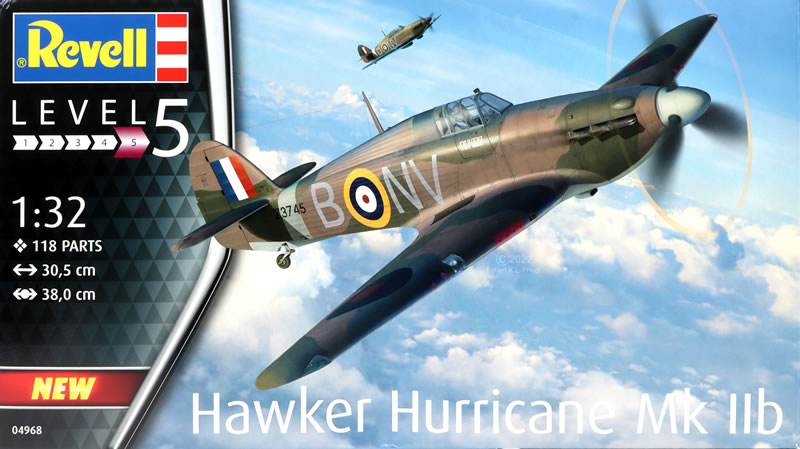
Revell,
1/32 scale
S
u m m a r y : |
Description and Item No.: |
Revell Kit No. 04968 - Hawker Hurricane Mk.IIb |
Contents and Media: |
147 parts in pale grey plastic (13 parts not used); 13 parts in clear plastic; markings for two aircraft; detailed illustrated instructions. |
Price: |
GBP£45.99 EU Price (£38.33 Export Price) Plus Shipping at Hannants |
Scale: |
1/32 |
Review Type: |
First Look |
Advantages: |
Convincing surface textures including stretched fabric effect; high level of detail; dropped or raised flaps included; separate control surfaces; alternative parts for open or closed canopy; perfectly printed decals from Cartograf; good outline and detail accuracy. |
Disadvantages: |
Flimsy side-opening box; some ejector pin circles may be visible in cockpit; care required to ensure correct dihedral; no bombs or drop tanks. |
Recommendation: |
Revell’s brand new 1/32 scale Hurricane Mk.IIb appears to take the same approach as their current 1/32 scale Bf 109 G family - sensible engineering, no gimmicks, nice surface textures, good level of detail straight from the box and by all reports so far, good fit.
On the other hand the pale plastic obscures some of the surface textures, but it will all look good under paint.
Revell's big Hurricane is not a "super kit". It does not feature an engine or full interior detail. Models like this do, however, fulfil an important role as an "everymodeller" kit - a straightforward build at a reasonable price.
These kits are worthy successors to the classic 1/32 scale Revell kits of the 1960s. I am very pleased that Revell has added the Hurricane to their list of new tool projects. |
Reviewed by Brett Green

Background
The Hawker Hurricane was Britain's first modern monoplane fighter aircraft, entering service in 1937.
Hawker's chief designer, Sidney Camm, designed the Hurricane around the new Rolls-Royce Merlin engine. Although the British Air Ministry had not yet placed an order, Hawker nevertheless prepared for the production of 1,000 aircraft. This head start significantly expedited delivery once the order for 600 Hurricanes was received in June 1936.
In addition to the fabric covered rear fuselage, the earliest versions of the Hurricane featured fabric wings, reflecting the earlier production techniques of the Hawker Aircraft Company. These initial 600 aircraft were also fitted with a fixed pitch, two-bladed wooden Watts propeller, although these were quickly supplanted by de Havilland and Rotol three-bladed propeller assemblies that permitted pitch adjustment from the cockpit. The later improved aircraft also included windscreens with armoured glass. In time, the fabric wings of many of these early Hurricanes were replaced with metal wings.

Although the Hurricane could absorb an enormous amount of punishment and could out-turn the Messerschmitt Bf 109 (and even the Spitfire) it was a slower aircraft. In the air war over France, the Bf 109 E showed itself to be somewhat superior to the Hurricane, especially those fitted with the two-bladed Watts propeller, but the British fighter had the edge over the prestigious twin-engined Bf 110. During the Battle of Britain, the Hurricane’s main role was to engage Luftwaffe bombers, with Spitfires tackling the more nimble German fighters. Although the fabric wing was largely phased out by this time, there were still examples of the type in use over England in that fateful summer of 1940.
Less glamorous than its legendary stablemate, the Hawker Hurricane was nevertheless a key factor in the RAF's victory in the Battle of Britain.
Hurricane Mk.IIb
The Hurricane Mk.II was powered by the improved Merlin XX engine with two-speed supercharger. The new engine was longer than the earlier Merlin and so the Hurricane gained a 4.5 in "plug" in front of the cockpit, which made the aircraft slightly more stable due to the slight forward shift in centre of gravity.

The Hurricane Mk.IIb was equipped with a new and slightly longer propeller spinner, and 4 additional wing-mounted .303 in (7.7 mm) Browning machine guns; for a total of 12 guns. The first aircraft were built in February 1941.
There have been a number of choices for modellers wishing to build a 1/32 scale Hurricane.
Revell offered a late version Hurricane Mk.I (metal wing) in the 1960s that was quite accurate in outline but suffered from the simple cockpit, wheel wells and undercarriage plus the gimmicky moving parts typical of the era. This was later perfunctorily modified and released as a Mk.II, but it retained many of the specific Mk.I characteristics.
Pacific Coast Models released two limited-run 1/32 scale Hurricane Mk.I kits in 2011 - early f abric wing and the later metal wing versions. I built the metal wing version of the kit at the time and it was a decent kit with a high level of detail including resin and photo-etched parts.
Fly Model followed with a whole family of 1/32 scale Hurricanes - Mk.I, Mk.IIb, Mk.IIc, Sea Hurricane Mk.IIc and Mk.IId. I haven't seen these in the flesh but they appear to be nice limited run kits.
Revell has now come to the party with a long-run injection moulded all-plastic Hawker Hurricane Mk. IIb.
This kit has absolutely nothing in common with the Revell USA Hurricane kits from the 1960s.
Revell's 1/32 scale Hawker Hurricane Mk. IIb comprises 147 parts in pale grey plastic (13 parts not used), 13 parts in clear plastic, markings for two aircraft and detailed illustrated instructions.
The box is the flimsy side-opening style. I would prefer a more robust box with a separate lid.
Surface detail is very nice. Recessed fine panel lines are supplemented by subtle stretched fabric effect on the mid to rear fuselage, the wings and the tail planes. Fasteners are depicted by circles on the engine cowling and fuselage. The overall impact is restrained and impressive.
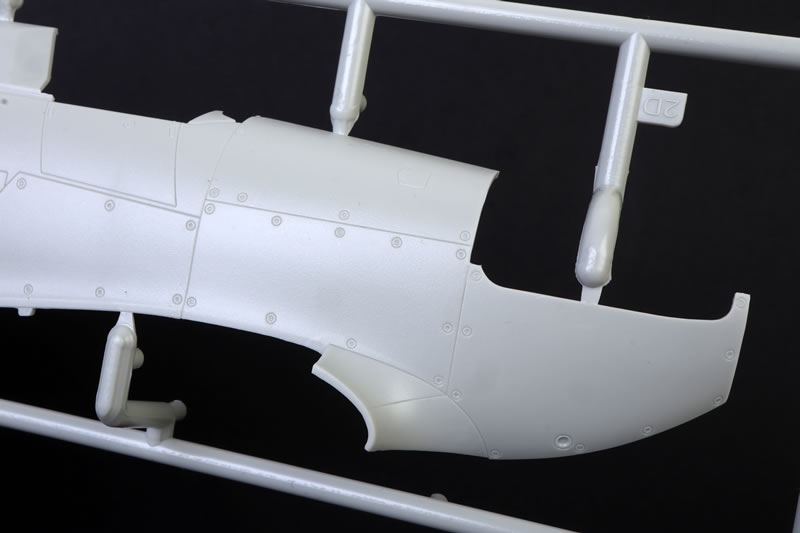
On the other hand the pale plastic obscures some of the surface textures, but it will all look good under paint.
There are also a number of recessed ejector pin circles on the inside of the fuselage. These will be partly hidden by the layers of cockpit frame detail but might be worth filling and sanding prior to assembly.
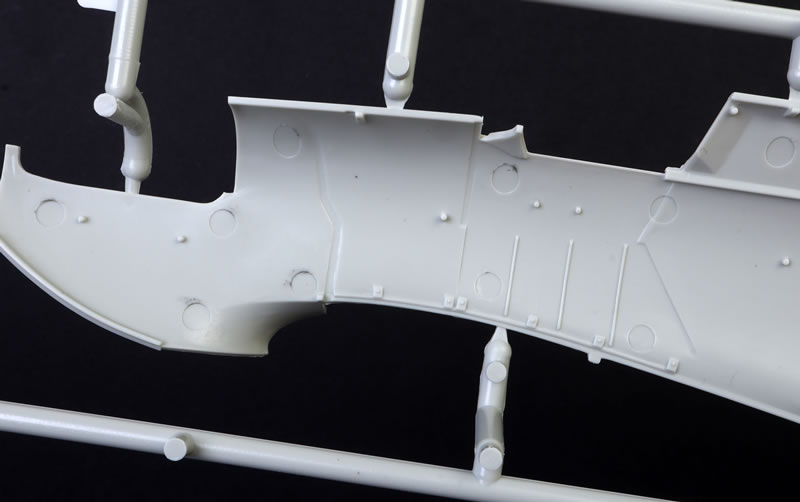
Interior detail is very nice. The cockpit's surrounding Warren girder-type fuselage interior of high-tensile steel tubes, frames and longerons is well depicted.
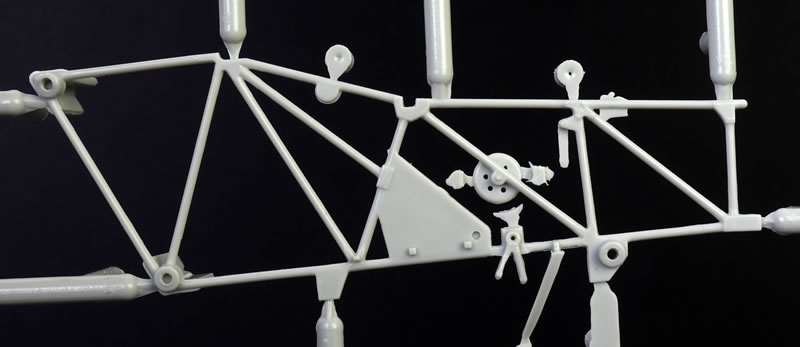
The seat is made up from four parts but no harness is supplied.
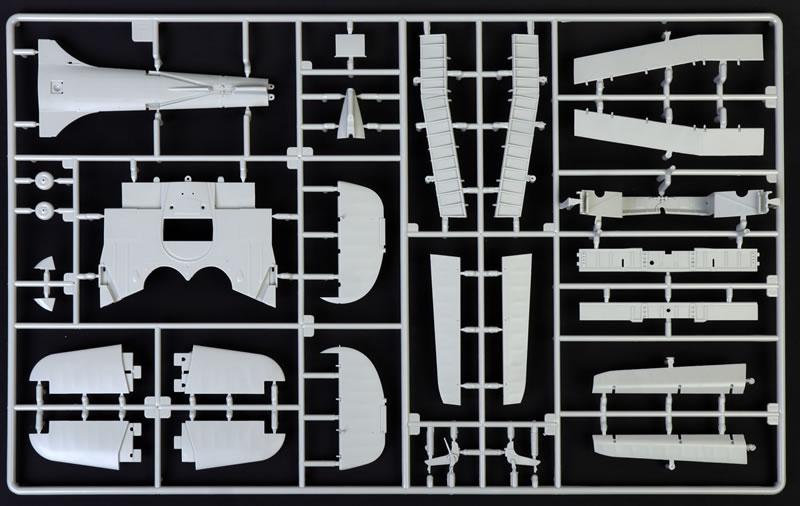
The port sidewall features a map case, paired on the starboard side with a console perched on tubular framing.

The bottomless cockpit floor with its distinctive footrails looks good too.
The instrument panel features raised bezels and switches that should respond well to painting and dry brushing. Decals are supplied as an alternative finish for the instrument panel.
The wings are presented as upper and lower left and right halves, with a separate middle-lower section. The wings are held in place with stout tabs and a short wing spar. Take care to ensure that the correct dihedral is set for the wings. The angle of incidence was 2° 0′, and the outer wing panels had 3° 30′ dihedral.
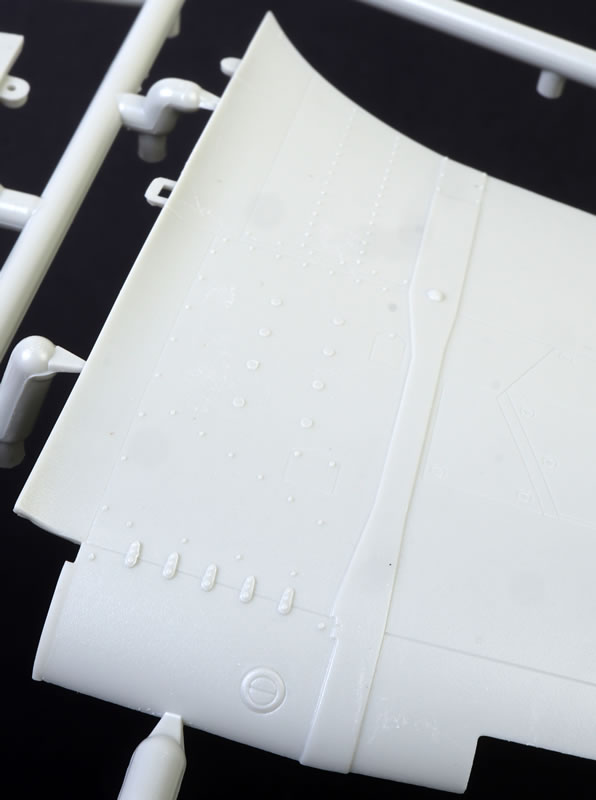
The main undercarriage bay is built inside the lower mid-wing section. Detail looks great
Control surfaces are separate parts and may be posed to taste. Two sets of optional parts are supplied so the flaps may be posed dropped or retracted. This is a nice easy approach whether you plan to build your flaps up or down.
Landing lights and the outboard machine guns are inserts for the leading edges of the wings.
A number of extra parts are supplied but most of these relate to other variants. These include a Vokes tropical filter for the lower cowl, an alternative lower rear fuselage with recessed arrestor hook, four Hispano 20mm cannon barrels and more. All of these point towards a Sea Hurricane, Hurricane Mk.IIc and trop versions in the future.
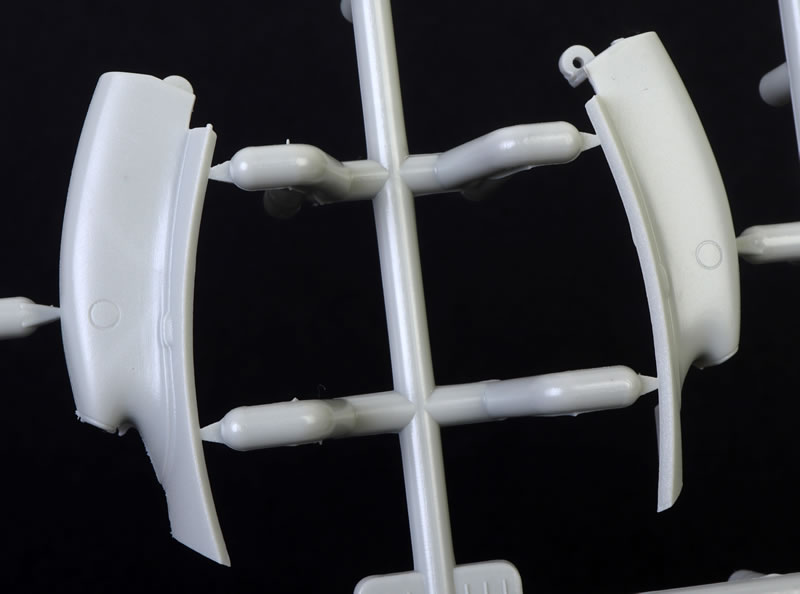
Two styles of cowl ring are offered. Check the instructions to see which fits where. Other optional parts include two styles of exhaust, alternative mirrors and raised or lowered pilot's entry step.
The clear parts are thinly moulded and good looking in shape. Revell has supplied different parts for the open and closed canopy - single part for closed and two pieces for open.

Engineering and parts breakdown is conventional.
The overall profile and plan form looks accurate.
Markings
Markings are supplied for two subjects - one in Temperate Land Scheme of Dark Green and Dark Earth over Sky, and a night fighter in oiverall Night (flat black).
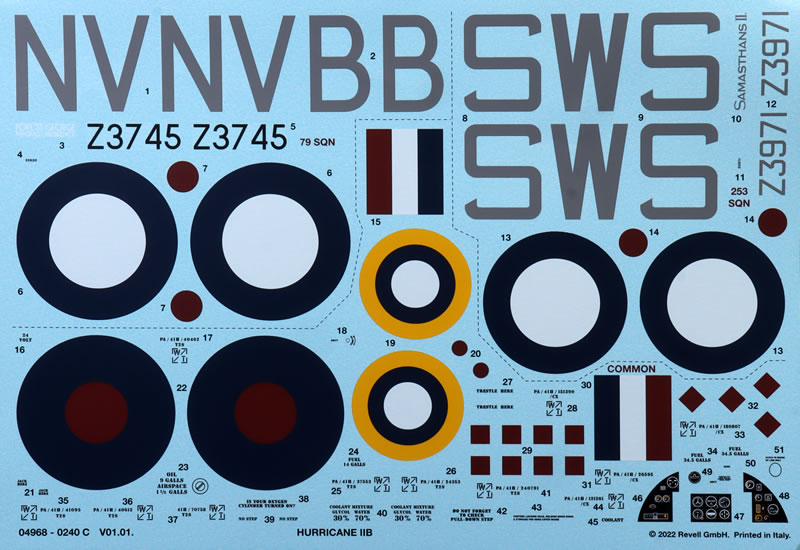
Decals are fairly flat in finish and printed by Cartograf.
Stencils and instrument dials are included on the sheet.
Revell’s brand new 1/32 scale Hurricane Mk.IIb appears to take the same approach as their current 1/32 scale Bf 109 G family - sensible engineering, no gimmicks, nice surface textures, good level of detail straight from the box and by all reports so far, good fit.
On the other hand the plastic does the kit no favours, being slightly pebbly in places and the very pale shade obscuring some of the surface textures, but it should all look good under paint.
Revell's big Hurricane is not a "super kit". It does not feature an engine or full interior detail. Models like this do, however, fulfil an important role as an "everymodeller" kit - a straightforward build at a reasonable price.
These kits are worthy successors to the classic 1/32 scale Revell kits of the 1960s. I am very pleased that Revell has added the Hurricane to their list of new tool projects.
Purchased by Reviewer
Review Text and Images Copyright © 2022 by Brett Green
Page Created 6 January, 2023
Last updated
6 January, 2023
Back to HyperScale Main Page
Back to Reviews Page

|
Home
| What's New |
Features |
Gallery |
Reviews |
Reference |
Forum |
Search